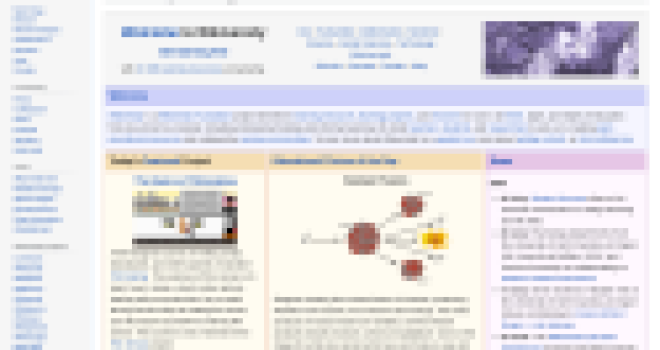LabLynx Wiki

Physiologic monitors monitor vital sign parameters and inform clinicians of changes in a patient's condition through the use of alarms. They consist of multiple components, including a central station, bedside monitors, and telemetry transmitters and receivers [1]. They initially developed out of the need for anesthesiologists to monitor patients in the operating room but quickly spread to the intensive care unit in the 1970s and throughout the hospital from there.
LIMSpec Wiki

Physiologic monitors monitor vital sign parameters and inform clinicians of changes in a patient's condition through the use of alarms. They consist of multiple components, including a central station, bedside monitors, and telemetry transmitters and receivers [1]. They initially developed out of the need for anesthesiologists to monitor patients in the operating room but quickly spread to the intensive care unit in the 1970s and throughout the hospital from there.
Bioinformatics Wiki

Physiologic monitors monitor vital sign parameters and inform clinicians of changes in a patient's condition through the use of alarms. They consist of multiple components, including a central station, bedside monitors, and telemetry transmitters and receivers [1]. They initially developed out of the need for anesthesiologists to monitor patients in the operating room but quickly spread to the intensive care unit in the 1970s and throughout the hospital from there.
IHE Wiki

Physiologic monitors monitor vital sign parameters and inform clinicians of changes in a patient's condition through the use of alarms. They consist of multiple components, including a central station, bedside monitors, and telemetry transmitters and receivers [1]. They initially developed out of the need for anesthesiologists to monitor patients in the operating room but quickly spread to the intensive care unit in the 1970s and throughout the hospital from there.
HL7 Wiki

Physiologic monitors monitor vital sign parameters and inform clinicians of changes in a patient's condition through the use of alarms. They consist of multiple components, including a central station, bedside monitors, and telemetry transmitters and receivers [1]. They initially developed out of the need for anesthesiologists to monitor patients in the operating room but quickly spread to the intensive care unit in the 1970s and throughout the hospital from there.
Clinfowiki

Physiologic monitors monitor vital sign parameters and inform clinicians of changes in a patient's condition through the use of alarms. They consist of multiple components, including a central station, bedside monitors, and telemetry transmitters and receivers [1]. They initially developed out of the need for anesthesiologists to monitor patients in the operating room but quickly spread to the intensive care unit in the 1970s and throughout the hospital from there.
OpenWetWare

Physiologic monitors monitor vital sign parameters and inform clinicians of changes in a patient's condition through the use of alarms. They consist of multiple components, including a central station, bedside monitors, and telemetry transmitters and receivers [1]. They initially developed out of the need for anesthesiologists to monitor patients in the operating room but quickly spread to the intensive care unit in the 1970s and throughout the hospital from there.
Statistical Genetics Wiki

Physiologic monitors monitor vital sign parameters and inform clinicians of changes in a patient's condition through the use of alarms. They consist of multiple components, including a central station, bedside monitors, and telemetry transmitters and receivers [1]. They initially developed out of the need for anesthesiologists to monitor patients in the operating room but quickly spread to the intensive care unit in the 1970s and throughout the hospital from there.
Cloud-Standards.org

Physiologic monitors monitor vital sign parameters and inform clinicians of changes in a patient's condition through the use of alarms. They consist of multiple components, including a central station, bedside monitors, and telemetry transmitters and receivers [1]. They initially developed out of the need for anesthesiologists to monitor patients in the operating room but quickly spread to the intensive care unit in the 1970s and throughout the hospital from there.
WikiBooks

Physiologic monitors monitor vital sign parameters and inform clinicians of changes in a patient's condition through the use of alarms. They consist of multiple components, including a central station, bedside monitors, and telemetry transmitters and receivers [1]. They initially developed out of the need for anesthesiologists to monitor patients in the operating room but quickly spread to the intensive care unit in the 1970s and throughout the hospital from there.
LIMSwiki

Physiologic monitors monitor vital sign parameters and inform clinicians of changes in a patient's condition through the use of alarms. They consist of multiple components, including a central station, bedside monitors, and telemetry transmitters and receivers [1]. They initially developed out of the need for anesthesiologists to monitor patients in the operating room but quickly spread to the intensive care unit in the 1970s and throughout the hospital from there.
Wikiversity

Physiologic monitors monitor vital sign parameters and inform clinicians of changes in a patient's condition through the use of alarms. They consist of multiple components, including a central station, bedside monitors, and telemetry transmitters and receivers [1]. They initially developed out of the need for anesthesiologists to monitor patients in the operating room but quickly spread to the intensive care unit in the 1970s and throughout the hospital from there.
Wikipedia

Physiologic monitors monitor vital sign parameters and inform clinicians of changes in a patient's condition through the use of alarms. They consist of multiple components, including a central station, bedside monitors, and telemetry transmitters and receivers [1]. They initially developed out of the need for anesthesiologists to monitor patients in the operating room but quickly spread to the intensive care unit in the 1970s and throughout the hospital from there.
















